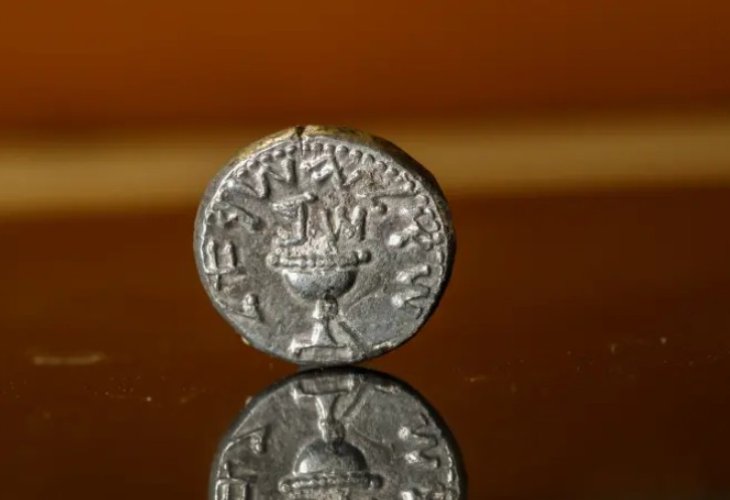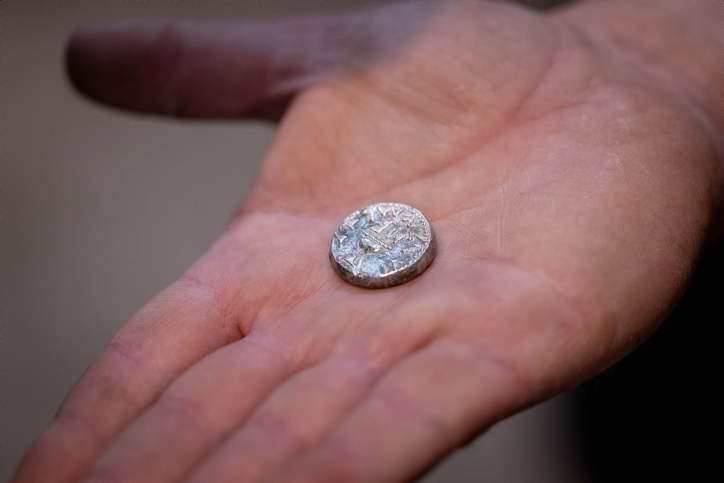A Rare Silver Coin from Jerusalem's Ancient Past Unearthed
During an archaeological dirt-sifting activity, an 11-year-old discovered a rare pure silver coin engraved with "Holy Jerusalem." Researchers estimate it originated from Second Temple treasures.
 The silver coin unearthed (Photo: Eliyahu Yanai, Israel Antiquities Authority and City of David)
The silver coin unearthed (Photo: Eliyahu Yanai, Israel Antiquities Authority and City of David)A rare silver coin from the end of the Second Temple period was discovered during an archaeological dirt-sifting activity conducted by the Israel Antiquities Authority on the stepped street in the City of David. The coin was found by 11-year-old Liel Crotokop from Petach Tikva, who participated in the "Archaeological Experience" at the Tzurim Valley National Park in Jerusalem with her family.
The coin is made of pure silver and weighs approximately 14 grams. One side features a goblet along with the inscription "Shekel Israel". Next to the goblet are the letters "Shin Bet", representing "Year Two" of the Great Revolt against the Romans (67-68 CE).
The opposite side depicts what researchers identify as the staff of the high priest, with the words "Holy Jerusalem" written in ancient Hebrew script.
According to Dr. Robert Cole, head of coins at the Israel Antiquities Authority, "This is an exceptionally rare find. Out of thousands of coins discovered so far in archaeological excavations, only about 30 are made of silver from the time of the Great Revolt."
 (Photo: Yonatan Zindel, Flash 90)
(Photo: Yonatan Zindel, Flash 90)Ari Levy, one of the excavation directors from the Israel Antiquities Authority, adds: "This street, connecting the Pool of Siloam in the south of the City of David to the Temple Mount in the north, served as the main street of Jerusalem during the Second Temple period. Thousands of pilgrims walked it on their way to the Temple. There's no doubt that there was extensive trading activity here, as evidenced by the many weights and bronze coins found. But discovering a revolt coin made of pure silver is truly special and exciting".
Dr. Cole believes the coin was crafted from the extensive silver reserves of the Temple and minted on the Temple Mount by a priest possibly working in coordination with the revolt leaders. "This is silver of very high quality. Where else could such a large quantity and high quality of silver be found in those days? Only at the Temple. Therefore, we can cautiously state that this coin is likely one of the few items we can hold today that originated from the Temple itself."
During the excavation, the archaeological soil was sent for wet-sifting at the Tzurim Valley National Park. As mentioned, it was Liel who got the chance to discover this find when she came with her parents and sister for the sifting activity: "We poured the bucket with the dirt onto the sieve, and as we sifted through the stones inside, I saw something round," she recounted.
"At first, I didn't know what it was, but it looked different from all the other stones. My dad showed it to one of the workers, who then took it to an archaeologist. He looked at it and said it was a silver coin needing cleaning. I was very excited."
The coin was sent to the Israel Antiquities Authority's laboratories for a chemical cleaning process. Recently, upon completion of the process, the significance of the find became clear.
"A coin is a symbol of sovereignty," concludes Dr. Cole. "If you're launching a revolt, one of the most distinctive symbols of asserting independence is minting coins. The inscription on the coin clearly expresses the rebels' aspirations. Choosing to use ancient Hebrew, which was no longer in use at the time, is no coincidence. It reflects the era's longing for the days of David and Solomon and for the united kingdom—days when the people of Israel had full independence in their land."

